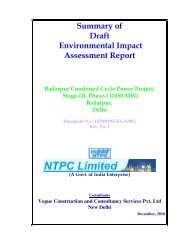proposed integrated complex for delhi judicial academy
proposed integrated complex for delhi judicial academy
proposed integrated complex for delhi judicial academy
Create successful ePaper yourself
Turn your PDF publications into a flip-book with our unique Google optimized e-Paper software.
Rapid Environmental Impact Assessment (REIA) Study <strong>for</strong> Proposed Integrated Complex <strong>for</strong> Delhi Judicial Academy,<br />
National Law School, and National Institute <strong>for</strong> Mediation & Conciliation at Dwarka, New Delhi<br />
the A weighted Scale which is measured as dB (A). This is more suitable <strong>for</strong> audible range of<br />
20 to 20,000 Hz.<br />
The acoustical environment varies dynamically in magnitude and character through out most<br />
communities. The noise level variation can be temporal, spectral and spatial. The residential noise<br />
level is that level below which the ambient noise does not seem to dropdown during the given<br />
interval of time and is generally characterised by unidentified sources. Ambient noise level is<br />
characterised by significant variations above a base or a residential noise level. The maximum<br />
impact of noise is felt on urban areas, which is mostly due to the commercial activities and<br />
vehicular movement during peak hours of the day.<br />
Measured noise levels displayed as a function of time provides a useful scheme <strong>for</strong> describing the<br />
acoustical climate of a community. Noise levels recorded at each station with a time interval of<br />
about 30 minutes are computed <strong>for</strong> equivalent noise levels (L eq ). Equivalent noise level is a single<br />
number descriptor <strong>for</strong> describing time varying noise levels.<br />
L eq is the equivalent continuous sound level that is equivalent to the same sound energy as the<br />
actual fluctuating sound measured in the same period. This is necessary because sound from noise<br />
source often fluctuates widely during a given period of time. This is calculated from the following:<br />
L day is defined as the equivalent noise level measured over a period of time during day (6 am to 10<br />
pm).<br />
L night is defined as the equivalent noise level measured over a period of time during night (10 pm to<br />
6 am).<br />
A noise rating developed by Environment Protection Agency, USEPA <strong>for</strong> specification of<br />
community noise from all the sources is the Day-Night Sound Level, L dn .<br />
The noise rating developed <strong>for</strong> community noise from all sources is the Day- Night Sound Level<br />
(L dn ). It is similar to a 24 hr equivalent sound level except that during night time period (10 pm to 6<br />
am) a 10 dB (A) weighting penalty added to the instantaneous sound level be<strong>for</strong>e computing the 24<br />
hr average.<br />
L eq = 10 log 1/T N i=1 Ti (10) Li/10<br />
Where, T = total time of sampling,<br />
Ti = Time duration of ith phase<br />
N = Number of phases<br />
Li = L eq <strong>for</strong> the ith phase<br />
This night time penalty is added to account <strong>for</strong> the fact that noise during night when people usually<br />
sleep is judged as more annoying than the same noise during the day time.<br />
68
















